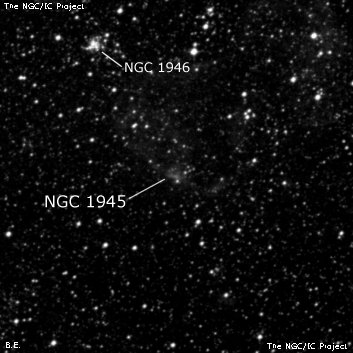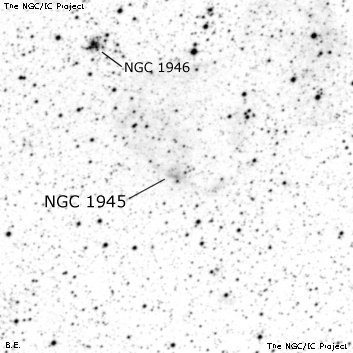NGC/IC Project Restoration Effort
(This is a very very beta version)
NGC1945


Basic Information
Location and Magnitude
Right Ascension: 5:24:54.0
Declination: -66:27:12
Constellation: DOR
Visual Magnitude:
Historic Information
Discoverer: Dunlop
Year of discovery: 1826
Discovery aperture: 9.0
Observational
Summary description: eeeF, vvL, irr dif
Sub-type: EN
Corwin's Notes
=====
NGC 1945. JH found this on 3 Jan 1837, calling it "eeF, vvL. Great blotches
of diffused nebulosity." His position points to the brightest "blotch" at the
southeastern tip of two or three annular nebulae south and west of NGC 1946, a
small unresolved cluster (with a good position) that he found in the same
sweep. If JH did indeed see the annular nebulae that I'm looking at -- it has
a butterfly shape and is about 7.0 x 4.5 arcmin across -- I'm surprised that
he did not mention the much brighter nebulosity enveloping the association
NGC 1948, which he also found in the same sweep. So, I've marked the
identification uncertain.
In any case, JH's description suggests that his nebula filled his field, so I
am going to assume that the center is not the brightest knot that JH measured,
but is about five arcminutes to the northwest near a star at the intersection
of the annuli (where the butterfly's "wings" would attach to its "body").
I've also measured JH's knot, of course. Jenni Kay takes this knot to be
NGC 1945, noting it to be -- with averted vision at 150X -- "... an extremely
faint, relatively small, round, hazy glow, about 40 [arcsec] in size." This
is clearly just a small part of the "vvL" nebula that JH saw.
Steve's Notes
=====
NGC 1945
24" (11/18/12 - Magellan Observatory, Australia): at 200x unfiltered, this LMC HII region appeared fairly faint, fairly small, ~30" diameter. Irregular shape, brighter along the south edge. NGC 1946 lies 4.4' NE. Several mag 11-13 stars are in the field to the northwest and these seem to stream 10' to the northeast direction, heading towards NGC 1948, a magnificent star cloud and HII complex. NGC 1951, a bright cluster, lies 11' SE and NGC 1941 is 12' NW.



